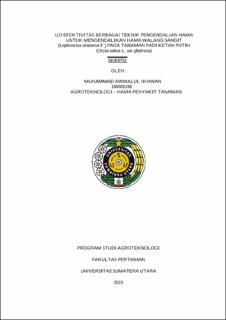Uji Efektivitas Berbagai Teknik Pengendalian Hama untuk Mengendalikan Hama Walang Sangit (Leptocorisa oratorius F.) pada Tanaman Padi Ketan Putih (Oryza sativa L. var glutinosa)
Testing the Effectiveness of Various Pest Control Techniques to Control the Sangit Walang Pest (Leptocorisa oratorius F.) on White Glutinous Rice Plants (Oryza sativa L. var glutinosa)

Date
2024Author
Ikhwan, Muhammad Awwalul
Advisor(s)
Siregar, Ameilia Zuliyanti
Metadata
Show full item recordAbstract
This research aims to determine the effectiveness of various pest control techniques to control the stink bug (Leptocorisa oratorius F.) on white sticky rice plants on Jalan Harmonika Baru, Padang Bulan Selayang II, Medan City, insect identification at the Plant Pest and Disease Laboratory, Faculty of Agriculture, University of North Sumatra which was carried out from May to October 2023. This research used a purposive sampling method with 3 types of treatments, including: application of carcass traps for golden snails, application of papaya leaf extract vegetable pesticide, spraying application of Beauveria bassiana. The results showed that the insects caught in the three treatments had the same number of orders and families, namely 5 orders and 19 families. 2593 by application of golden snail carcass traps, 743 by application of papaya leaf extract vegetable pesticide, 528 by spraying Beauveria bassiana. The total value of AD and AF in the golden snail carcass trap treatment was a total of AD=2,593 AF=359, and the papaya leaf vegetable pesticide treatment was a total of AD=743 AF=138, and the Beauveria bassiana treatment was a total of AD= 528 AF=137. The calculation of the species richness index (R):(R=7,57 R=7,67 R=2,64), evenness index (E): (E=0,80 E=0,80 E=0,75), dominance index (C):(C=1 C=1 C=1), insect diversity index (H):(H =2,48 H=2,64 H= 2,70). From the results of this research, trapping treatment for golden golden snail carcasses (Pomacea canaliculata) is the best treatment. The functional status of insects has been identified as many as 3 types, namely herbivores, predators and scavengers
Collections
- Undergraduate Theses [3388]
